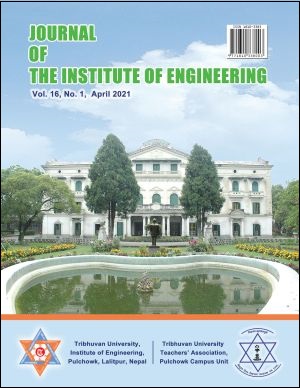Risk Rating for Risk-Based Maintenance: A Case Study of Small Hydropower Plant in Nepal
DOI:
https://doi.org/10.3126/jie.v16i1.36560Keywords:
Critical analysis, Critical Assets, Hydropower, Maintenance, Risk, ReliabilityAbstract
Fourth generation maintenance philosophy and Quality management system 9001:2015, emphasis on the concept of risk based thinking. And it is one of the challenging part of maintenance department to adopt these philosophy by quantifying all the activities of the department. Risk rating based on reliability is one of the techniques to quantify the maintenance activities for those organizations, whose reliability of goods and services matter in the market. Hydropower sector is also among them whose reliability matters highly in consumer life standard. So this paper approaches to rate the risk of hydropower based on the reliability of components for the implementation of Risk-based maintenance. From the study of data recorded in log book of a small hydropower plant located in western part of Nepal, it was found that the overall reliability score of the plant was 0.9819, which was low as compared to other hydropower of Nepal, where turbine section of both the units of the plant found a higher risk score than other systems. Study adopted two tools i.e. Analytical Hierarchical based Fault Tree Analysis and Critical Analysis Technique to find the critical assets and Failure Mode and Effect Analysis for the rest of all to quantifying the risk in component level. The analysis shows that the cooling system as the critical asset for both the units and it contributes 72% and 64% in the reliability of the turbine section. The critical assets thus obtained was validated through the critical analysis technique. From which the risk score of cooling system found 90% in both the units. To analyze the risk in component level, Failure Mode and Effect Analysis of different sub component of critical assets was done. Among the sub-components of the cooling system, radial tube filter gets the highest risk score. Its components; cartridge, tube, and joints have the risk score of 450, 192, and 96 respectively. And from the critical analysis of the rest of the subsystems of uint-I and unit-II, components such as bearings, breaker of the transmission system, transmission equipment, excitation system and transformer of unit-I and breaker of the transmission system, transmission equipment and excitation system of unit-II are found to have higher critical score, hence, it is recommended to apply preventive activities on these components as per the manufacturer to reduce the risk that could be caused by their failure.Downloads
Download data is not yet available.
Abstract
279
pdf
432
Downloads
Published
2021-04-12
How to Cite
Sharma, R., Bhattarai, N., & Neupane, S. (2021). Risk Rating for Risk-Based Maintenance: A Case Study of Small Hydropower Plant in Nepal. Journal of the Institute of Engineering, 16(1), 87–94. https://doi.org/10.3126/jie.v16i1.36560
Issue
Section
Articles
License
The Copyright is held by Journal of the Institute of Engineering, IOE, TU




